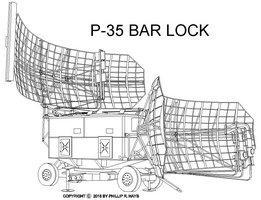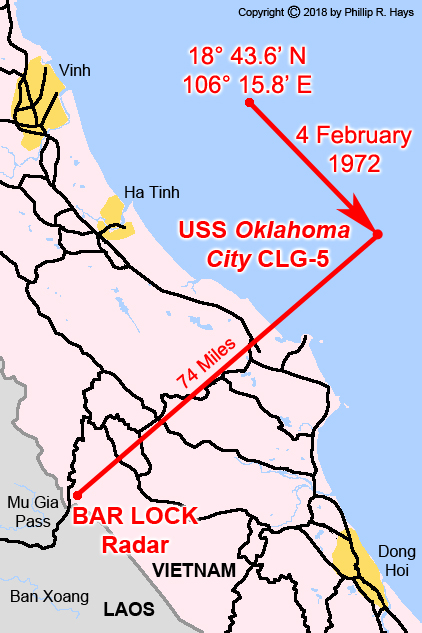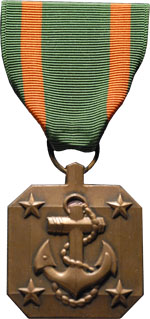I was Nuclear/Special Weapons Officer on the USS Oklahoma City CLG-5 from January 1970 through April 1972. I was assigned to GM Division that maintained and operated the Talos missiles and launching system. I stood watch as the Weapons Control Officer, and was on duty in Weapons Control when the US Navy's first successful combat surface-to-surface anti-radiation (radar) missile shot was fired. Personnel directly involved with the mission received the Navy Achievement Medal "for professional achievement from 29 January 1972 to 5 February 1972." Unfortunately, the Navy apparently has lost all records of this bit of US Navy history, so I have had to piece the story together from the recollections and notes of people who were there when it happened. *
North Vietnam was trying to set up mobile air traffic control radars to allow them to vector fighters and SAMs (Surface to Air Missiles) to intercept our bombers. Without air coordination their air force was not very effective. The US Navy, Marines and Air Force had pretty much blown away every fixed radar installation. The NVN had some Russian mobile radar vans, and cleared flat spots on mountain tops so they could park the mobile radars at a number of places. When they detected our aircraft headed their way they shut down and hid under camouflaged cover. The Pentagon wanted a long range fast strike capability to attack these mobile units. The Talos RGM-8H ARM (Anti Radiation Missile) was developed for this purpose in the late 1960s. The Oklahoma City conducted some of the development shots off California in 1968 before returning to WESTPAC.
In the spring of 1971 the Oklahoma City executed an underway replenishment to take aboard the new, highly classified, RGM-8H anti-radiation version of the Talos missile. We conducted a test firing off Okinawa in July 1971 to train the crew with the ARM missiles. Then we waited for an opportunity to use them.

In late 1971 the NVN army was massing equipment and personnel just north of the DMZ for a Tet offensive in February 1972, and moved missiles and aircraft south to provide cover for the buildup. They used their mobile radars to coordinate SAM and MiG operations and shot down several US aircraft. The Air Force flew "Wild Weasel" radar suppression aircraft to attack radar sites, but they had to approach to within about 30 miles to attack the radars, giving the NVN ample warning to launch missiles or shut down the radars. In December 1971 an Air Force Wild Weasel used an AGM-78 Standard ARM missile to destroy a BAR LOCK radar site near the Barthelemy Pass in North Vietnam. Covert personnel on the ground examined the site immediately after it was destroyed and discovered it had been manned by Russian operators. **
The P-35 BAR LOCK radar (Russian "Saturn") was an early warning long range (220 miles up to 82,000 feet) ground control radar that operated in the E and F bands with 1 megawatt output. It had two large parabolic antennas mounted on a trailer. It was capable of altering the pulse rate and frequency to counter attempts to "jam" the radar. The cab carrying the antennas rotated at 7 revolutions per minute.

In January 1972 the Oklahoma City steamed to the Gulf of Tonkin to do some "radar hunting." We were waiting for the chance to use the new RGM-8H missiles in the Ready Service Magazine. We were looking for another BAR LOCK radar in the vicinity of the Mu Gia Pass, although few people aboard knew this. We maintained a position about 30 miles off the coast of North Vietnam near Vinh (18° 43.6' N 106° 15.8' E) for most of the period from 28 January to 4 February, holding position within 2000 yards from a reference buoy, waiting to shoot. During this period we operated at Condition II AAW with the Talos missile battery and the 5"/38 guns manned, and with either the USS Decatur DDG-31 or the USS Mahan DLG-11 "riding shotgun" with their short range Tartar and Terrier missiles.
The USS Chicago CG-11 was also operating nearby on a similar radar hunting mission. The Chicago was a double end (two Talos missile batteries, bow and stern) guided missile heavy cruiser. The USS Oklahoma City was 7th Fleet flagship, but we were assigned to a cruiser/destroyer squadron for this action. So, although we were carrying The Boss, the operation was under the command of the squadron commander who was on the USS Chicago.
Of course, everyone wanted to be the first to use the new missiles. The squadron commander gave the first shot to his ship. At about 1730 (5:30 PM) on 3 February the Chicago fired a Talos ARM missile at a North Vietnamese radar site. The missile failed shortly into the flight. We heard later that it was a maintenance issue - the rear telemetry antenna vibrated loose because it had not been lock wired in place. ***
At 0430 (4:30 AM) on the morning of 4 February the Oklahoma City left the original operating position and set course 135° True and speed 14 knots for 2 1/2 hours to a new position about 35 miles southeast of the original station, in the southern end of the operations area. Throughout the day we steamed at "various courses and speeds" while keeping station near the new position.
On the evening of the 4th at about 2100 (9:00 PM) the Chicago fired a second Talos ARM missile, and it failed. A cause was never determined. ***
Well, we were all a bit frustrated at this point. As I recall, our Captain sent the squadron commander a message asking if he would like us to show them how it should be done. We got the OK while I was on watch in Weapons Control. The electronics warfare (EW) folks in CIC (Combat Information Center) detected emissions from a BAR LOCK air traffic control (ATC) radar and the fun started. The EW watch provided continuous updates to the fire control team, watching for frequency changes that might interfere with the shot.
I was on-watch that night in the EW shack and was on the receiver and picked up the BAR LOCK ATC radar that the Vietnamese were using. I remember the incident pretty vividly... how long we'd trained to be able to pick up those threat emitters, determine the key characteristics so we could pass on just the kind of info that was used to program the TALOS that night. Some of the measurement gear was NOT part of a standard electronics package. A few OW-div buddies and I collaborated to put together a couple pieces of outboard 'off-the-shelf' test equipment (an audio signal generator and XY scope so we could accurately determine PRR frequencies of incoming signals). It was this set up that allowed us to pass on not one...but three of the frequencies that BAR LOCK was using that night (since it was a Frequency Scanning...FRESCAN...radar to allow it to determine bearing/range AND approximate altitude).
I remember passing parameters on to the fire control folks continuously as the missile was being prepared for launch (BAR LOCK radars were notorious for changing frequencies during operation). I remember feeling/hearing the launch... I continued to monitor the signal as the missile was in-flight. After a minute or so (I didn't have a stopwatch on it) I remember hearing a weird screeching... then the signal went silent. Apparently that was the precise moment of the impact/explosion that "killed" the radar.
RD2 Doug Rasor, OK City 1968-72
We fired one Talos ARM missile and telemetry data showed it appeared to function correctly.
On the night of the ARM engagement, I recall leaving Weapons Control immediately after launch of the missile and running up to the Fire Control Workshop above Weapons Control, where the AN/SKQ-1 Telemetry set had been installed and was receiving data [TLM] from the missile in flight. Having set the pre-launch parameters into the missile, after discussion with CDR Mel Foreman [Weapons Department head], I knew what to look for in the telemetry as regards the general flow of the missile flight regime. FYI, the AN/SKQ-1 data was projected onto light sensitive paper for subsequent development and analysis.
I saw the missile acquire the Bar Lock radar, and wing movements generating the lateral accelerations as the missile acquired and began homing on the target. Angle Rate Gate Enable had been transmitted to the missile prior to launch, so the missile had been fired to a point in space roughly 8 Kyds beyond the radar site, which caused the missile to reject possible “spoofing” targets beyond/to the side of the actual target. So the missile nosed over and dove on the target approaching from directly overhead and thereby maximizing the fuse/warhead effectiveness against the target. TLM was lost just prior to the predicted intercept so warhead fusing was not visible on TLM. However, all of the available TLM data suggested that the missile had homed on (and probably destroyed) the target.
WO1 Greg Dilick, OK City 1970-73.
However, at the moment we didn't know if we had hit the target. The Electronics Warfare people in CIC told us the radar signal had disappeared about the same time the missile arrived, but you can bet the BAR LOCK operators would have noticed if we had missed and shut down their radar! The next day our Weapons Department head CDR Foreman showed me aerial recon photos. The radar antennas were scattered all over Southeast Asia, and what remained of the trailer was lying on its side at the edge of a 30 foot diameter crater.
This was all classified Secret at the time, and our missile crews were told to keep quiet. Of course everyone aboard knew something was going on (missile shots were very noisy). I overheard one sailor say we had fired a nuclear warhead and he had seen the explosion! Such is scuttlebutt!
The next morning at 0004 (four minutes after midnight) the Oklahoma City left the operating area for Yankee Station in the Gulf of Tonkin to rendezvous with the USS Coral Sea CVA-43 for personnel transfers. At 1339 (1:39 PM) we left the area and went to Subic Bay in the Philippines for R&R. The Chicago was in port when we arrived. Imagine our surprise when we learned that the bar girls knew about the shot before we got there! One of our first class POs told me that as they walked into a bar one of the girls saw the ship's name patch on his sleeve and started asking about the missile shot! So much for secrecy!
I think that is a pretty good first-hand description of what happened with the Talos anti-radar shot. The first successful combat surface-to-surface missile shot and ship to shore anti-radiation missile shot in US Navy history occurred between 2100 and 2400 4 February, 1972.
References
1. USS Oklahoma City CLG-5 Command History 1972.
2. USS Oklahoma City CLG-5 Deck Log 28 January, 1972, through 5 February, 1972.

